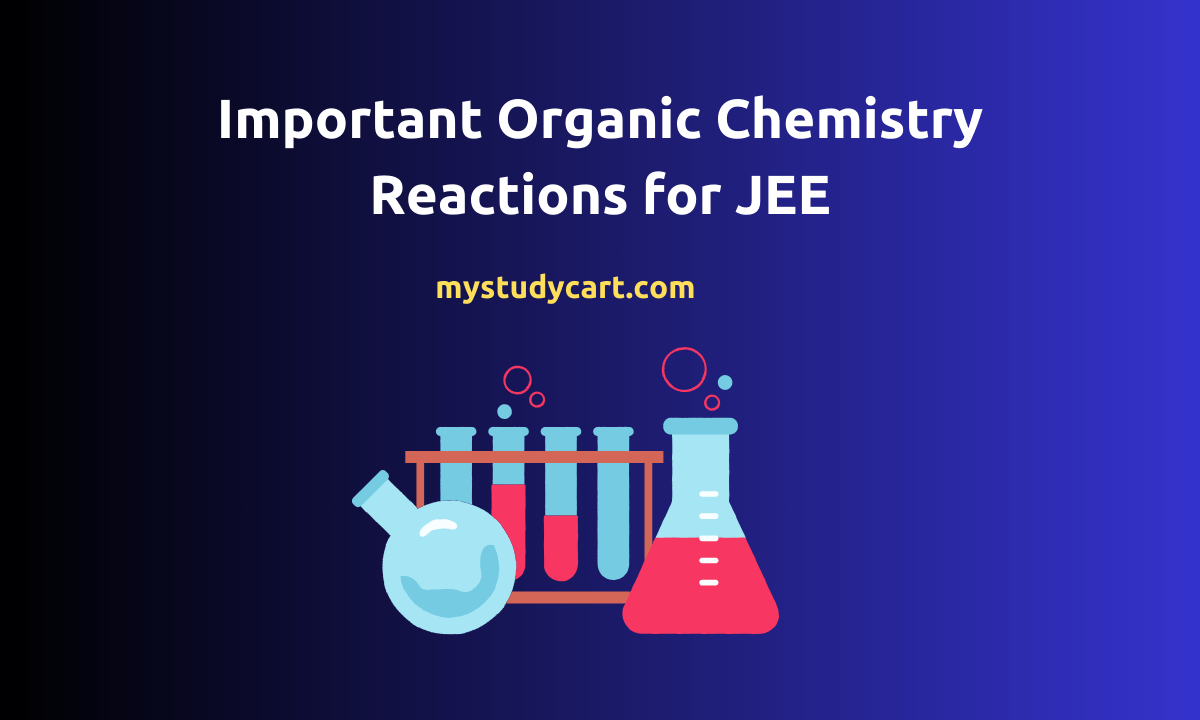
Organic chemistry is a crucial part of the JEE syllabus, and mastering the organic chemistry reactions is essential for scoring well in JEE chemistry. Here are some important organic chemistry reactions that JEE aspirants should focus on.
Key Organic Chemistry Reactions for JEE
1. Reactions of Alkanes
Free Radical Substitution
- Halogenation of Alkanes: R-H + X2 → R-X + HX (in the presence of UV light or heat)
2. Reactions of Alkenes
Electrophilic Addition Reactions
- Hydrogenation: R-CH=CH2 + H2 → R-CH2-CH3 (in the presence of a catalyst like Pt, Pd, or Ni)
- Halogenation: R-CH=CH2 + X2 → R-CHX-CHX
- Hydrohalogenation: R-CH=CH2 + HX → R-CH2-CH2X (Markovnikov’s rule)
- Hydration: R-CH=CH2 + H2O → R-CH2-CH2OH (in the presence of an acid catalyst)
3. Reactions of Alkynes
Electrophilic Addition Reactions
- Hydrogenation: R-C≡C-H + H2 → R-CH=CH2 + H2 → R-CH2-CH3 (in the presence of a catalyst like Pt, Pd, or Ni)
- Halogenation: R-C≡C-H + X2 → R-CHX-CHX
4. Reactions of Aromatic Compounds
Electrophilic Aromatic Substitution
- Nitration: Benzene + HNO3 → Nitrobenzene + H2O (in the presence of H2SO4)
- Sulfonation: Benzene + SO3 → Benzenesulfonic acid (in the presence of H2SO4)
- Halogenation: Benzene + X2 → Halobenzene + HX (in the presence of FeX3)
- Friedel-Crafts Alkylation: Benzene + R-X → Alkylbenzene + HX (in the presence of AlCl3)
- Friedel-Crafts Acylation: Benzene + R-COCl → Acylbenzene + HCl (in the presence of AlCl3)
5. Reactions of Alcohols
Nucleophilic Substitution and Elimination
- Dehydration: R-CH2-CH2OH → R-CH=CH2 + H2O (in the presence of an acid like H2SO4)
- Oxidation:
- Primary alcohol → Aldehyde → Carboxylic acid (using oxidizing agents like KMnO4 or K2Cr2O7)
- Secondary alcohol → Ketone
6. Reactions of Aldehydes and Ketones
Nucleophilic Addition
- Reduction:
- Aldehyde → Primary alcohol (using NaBH4 or LiAlH4)
- Ketone → Secondary alcohol
- Oxidation:
- Aldehyde → Carboxylic acid (using KMnO4 or K2Cr2O7)
Aldol Condensation
- Aldehydes and ketones: R-CHO + R’-CO → R-CH(OH)-CH2-R’ → R-CH=CH-R’ + H2O (in the presence of a base)
7. Reactions of Carboxylic Acids and Derivatives
Nucleophilic Acyl Substitution
- Formation of Esters: R-COOH + R’-OH → R-COOR’ + H2O (in the presence of an acid catalyst)
- Formation of Amides: R-COOH + NH3 → R-CONH2 + H2O (using dehydrating agents)
Decarboxylation
- Decarboxylation: R-COOH → R-H + CO2 (using soda lime)
8. Reactions of Amines
Basicity and Alkylation
- Formation of Quaternary Ammonium Salts: R-NH2 + R’-X → R-NH3+R’ + HX
- Gabriel Phthalimide Synthesis: Phthalimide + KOH + R-X → Primary amine
9. Reactions Involving Multiple Functional Groups
Cannizzaro Reaction
- Disproportionation of Aldehydes: 2R-CHO → R-COOH + R-CH2OH (in the presence of a strong base)
Claisen Condensation
- Condensation of Esters: 2R-COOR’ → β-keto ester (in the presence of a base)
Perkin Reaction
- Synthesis of α,β-Unsaturated Carboxylic Acids: Aromatic aldehyde + Acetic anhydride → α,β-unsaturated carboxylic acid (in the presence of a base)
These reactions form the backbone of many organic chemistry problems in JEE Mains and Advanced. Regular practice, thorough revision, and understanding the mechanisms of these reactions will significantly enhance your problem-solving skills and boost your confidence.
Related Post : Tips to Improve Organic Chemistry for JEE

